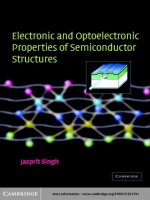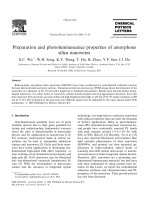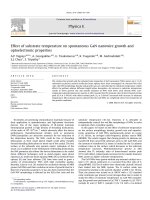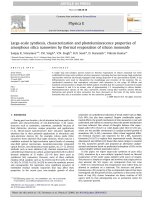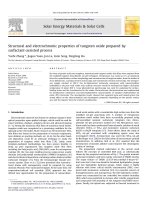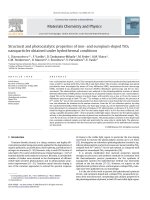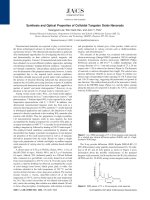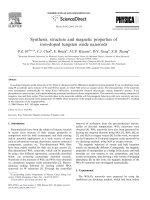- Trang chủ >>
- Khoa Học Tự Nhiên >>
- Vật lý
Electronic and Optoelectronic Properties of Semiconductor Structures
Bạn đang xem bản rút gọn của tài liệu. Xem và tải ngay bản đầy đủ của tài liệu tại đây (4.81 MB, 559 trang )
This page intentionally left blank
Electronic and Optoelectronic Properties of Semiconductor Structures presents the under-
lying physics behind devices that drive today’s technologies. The book covers important
details of structural properties, bandstructure, transport, optical and magnetic properties
of semiconductor structures. Effects of low-dimensional physics and strain – two important
driving forces in modern device technology – are also discussed. In addition to conven-
tional semiconductor physics the book discusses self-assembled structures, mesoscopic
structures and the developing field of spintronics.
The book utilizes carefully chosen solved examples to convey important concepts and has
over 250 figures and 200 homework exercises. Real-world applications are highlighted
throughout the book, stressing the links between physical principles and actual devices.
Electronic and Optoelectronic Properties of Semiconductor Structures provides engineering
and physics students and practitioners with complete and coherent coverage of key
modern semiconductor concepts. A solutions manual and set of viewgraphs for use in
lectures is available for instructors.
received his Ph.D. fr
om the University of Chicago and is Professor of
Electrical Engineering and Computer Science a
t the University of Michigan, Ann Arbor.
He has held visiting positions at the University of California, Santa Barbara and the
University of Tokyo. He is the author of over 250 technical papers and
of seven previous
textbooks on semiconductor
technology and applied physics.
Electronic and Optoelectronic Properties
of Semiconductor Structures
Jasprit Singh
University of Michigan, Ann Arbor
Cambridge, New York, Melbourne, Madrid, Cape Town, Singapore, São Paulo
Cambridge University Press
The Edinburgh Building, Cambridge , United Kingdom
First published in print format
- ----
- ----
© Cambridge University Press 2003
2003
Information on this title: www.cambrid
g
e.or
g
/9780521823791
This book is in copyright. Subject to statutory exception and to the provision of
relevant collective licensing agreements, no reproduction of any part may take place
without the written permission of Cambridge University Press.
- ---
- ---
Cambridge University Press has no responsibility for the persistence or accuracy of
s for external or third-party internet websites referred to in this book, and does not
guarantee that any content on such websites is, or will remain, accurate or appropriate.
Published in the United States of America by Cambridge University Press, New York
www.cambridge.org
hardback
eBook (NetLibrary)
eBook (NetLibrary)
hardback
PREFACE
INTRODUCTION
I.1 SURVEY OF ADVANCES IN SEMICONDUCTOR
PHYSICS
xiv
I.2 P
HYSICS BEHIND SEMICONDU
CTORS
xvi
I.3 R
OLE OF THIS BOOK
xviii
STRUCTURAL PROPERTIES
OF SEMICONDUCTORS
1.1 INTRODUCTION 1
1.2 CRYSTAL GROWTH
2
1.2.1 Bulk Crystal Growth 2
1.2.2 Epitaxial Crystal Growth 3
1.2.3 Epitaxial Regrowth 9
1.3 C
R
YSTAL STRUCTURE
10
1.3.1 Basic Lattice Types 12
1.3.2 Basic Crystal Structures 15
1.3.3 Notation to Denote Planes and Points in a Lattice:
Miller Indices
16
1.3.4 Artificial Structures: Superlattices and Quantum Wells 21
1.3.5 Surfaces: Ideal Versus Real 22
1.3.6 Interfaces 23
1.3.7 Defects in Semiconductors 24
CONTENTS
xiii
xiv
1
1
1.4 STRAINED HETEROSTRUCTURES 26
1.5 S
TRAINED TENSOR IN LATTICE MISMATCHED EPITAXY
32
1.6 P
OLAR MATERIALS AND POLARIZATION CHARGE
35
1.7 T
ECHNOLOGY CHALLENGES
41
1.8 P
ROBLEM
S
41
1.9 R
EFERENCES
44
SEMICONDUCTOR BANDSTRUCTURE
2.1 INTRODUCTION 46
2.2 BLOCH THEOREM AND CRYSTAL MOMENTUM 47
2.2.1 Significance of the k-vector 49
2.3 MET
ALS
, INSULATORS, AND
SEMICONDUCTORS
51
2.4 T
IGHT BINDING METHOD
54
2.4.1 Bandstructure Arising From a Single Atomic s-Level 57
2.4.2 Bandstructure of Semiconductors 60
2.5 S
PIN-ORBIT COUPLING
62
2.5.1 Symmetry of Bandedge States 68
2.6 O
RTHOGONA
LIZED PLANE WAVE METHOD
70
2.7 P
SEUDOPOTENTIAL METHOD
71
2.8 k
• p METHOD
74
2.9 S
ELECTED BANDSTRUCTURES
80
2.10 M
OBILE CARRIERS: INTRINSIC CARRIERS
84
2.11 D
OPING: DONORS AND ACCEPTORS
92
2.11.1 Carriers in Doped Semiconductors 95
2.11.2 Mobile Carrier Density and Carrier Freezeout 96
2.11.3 Equilibrium Density of Carriers in Doped Semiconductors 97
2.11.4 Heavily Doped Semiconductors 99
2.12 TECHNOLOGY CHALLENGES
102
2.13 PROBLEMS
104
2.14 R
EFERENCES
107
Con
tents
2
46
vi
BANDSTRUCTURE MODIFICATIONS
3.1 BANDSTRUCTURE OF SEMICONDUCTOR ALLOYS
109
3.1.1 GaAs/AlAs Alloy 113
3.1.2 InAs/GaAs Alloy 113
3.1.3 HgTe/CdTe Alloy 116
3.1.4 Si/Ge Alloy 117
3.1.5 InN, GaN, AlN System 117
3.2 B
ANDSTRUCTURE MODIFICATIONS BY HETEROSTRUCTURES
118
3.2.1 Bandstructure in Quantum Wells 119
3.2.2 Valence Bandstructure in Quantum Wells 123
3.3 SUB-2-DIMENSIONAL SYSTEMS
124
3.4 STRAIN AND DEFORMATION POTENTIAL THEORY 129
3.4.1 Strained Quantum Wells 137
3.4.2 Self-Assembled Quantum Dots 140
3.5 P
OLAR HETEROSTRUCTURES
142
3.6 TECHNOLOGY ISSUES
145
3.7 PROBLEMS 145
3.8 REFERENCES
149
TRANSPORT: GENERAL FORMALISM
4.1 INTRODUCTION
152
4.2 B
OLT
ZMANN TRANSPORT EQUATION
153
4.2.1 Diffusion-Induced Evolution of f
k
(r)
155
4.2.2 External Field-Induced Evolution of f
k
(r)
156
4.2.3 Scattering-Induced Evolution of f
k
(r)
156
4.3 A
VERAGING PROCEDURES
163
4.4 TRANSPORT IN A WEAK MAGNETIC FIELD:HALL MOBILITY 165
4.5 S
OLUTION OF THE BOLTZMANN TRANSPORT EQUATION
168
4.5.1 Iterative Approach 168
4.6 BALANCE EQUATION: TRANSPORT PARAMETERS 169
4.7 T
ECHNOLOGY ISSUES
175
4.8 P
ROBLEMS
176
4.9 R
EFERENCES
177
3
109
Contents vii
4
152
DEFECT AND CARRIER–CARRIER SCATTERING
5.1 IONIZED IMPURITY SCATTERING
181
5.2 ALLOY SCATTERING
191
5.3 N
EUTRAL IMPURITY SCATTERING
194
5.4 INTERFACE ROUGHNESS SCATTERING
196
5.5 C
ARRIER–CARRIER SCATTERING
198
5.5.1 Electron–Hole Scattering 198
5.5.2 Electron–Electron Scattering: Scattering of Identical Particles
201
5.6 AUGER PROCESSES AND IMPACT IONIZATION 205
5.7 PROBLEMS 213
5.8 REFERENCES 214
LATTICE VIBRATIONS: PHONON SCATTERING
6.1 LATTICE VIBRATIONS
217
6.2 P
HONON
STATISTICS
223
6.2.1 Conservation Laws in Scattering of Particles Involving
Phonons
224
6.3 POLAR
OPTICAL PHONONS
225
6.4 P
HONONS IN HETEROSTRUCTURES
230
6.5 P
HONON SCATTERING: GENERAL FORMALISM
231
6.6 L
IMITS ON PHONON WAVEVECTORS
237
6.6.1 Intravalley Acoustic Phonon Scattering 238
6.6.2 Intravalley Optical Phonon Scattering 239
6.6.3 Intervalley Phonon Scattering 240
6.7 A
COUSTIC PHONON SCATTERING
241
6.8 OPTICAL PHONONS: DEFORMATION POTENTIAL SCATTERING
243
6.9 O
PTICAL PHONONS: POLAR SCATTERING
246
6.10 INTERVALLEY SCATTERING
251
Contentsviii
5
179
6
217
6.11 ELECTRON–PLASMON SCATTERING 252
6.12 TECHNOLOGY ISSUES 253
6.13 PROBLEMS 254
6.14 REFERENCES
257
VELOCITY-FIELD RELATIONS
IN SEMICONDUCTORS
7.1 LOW FIELD TRANSPORT
261
7.2 HIGH FIELD TRANSPORT:MONTE CARLO SIMULATION 264
7.2.1 Simulation of Probability Functions by Random Numbers 265
7.2.2 Injection of Carriers 266
7.2.3 Free Flight 269
7.2.4 Scattering Times 269
7.2.5 Nature of the Scattering Event 271
7.2.6 Energy and Momentum After Scattering 272
7.3 S
TEADY STATE AND TRANSIENT TRANSPORT
288
7.3.1 GaAs, Steady State 288
7.3.2 GaAs, Transient Behavior 290
7.3.3 High Field Electron Transport in Si 291
7.4 B
ALANCE EQUATIO
N APPROACH TO HIGH FIELD T
RANSPORT
292
7.5 IMPACT IONIZATION IN SEMICONDUCTORS 295
7.6 T
RANSPORT IN QUANTUM WELLS
296
7.7 TRANSPORT IN QUANTUM WIRES AND DOTS 303
7.8 T
ECHNOLOGY ISSUES
305
7.9 PROBLEMS 306
7.10 R
EFERENCES
308
COHERENCE, DISORDER, AND
MESOSCOPIC SYSTEMS
8.1 INTRODUCTION
312
8.2 ZENER-BLOCH OSCILLATIONS 313
8.3 RESONANT TUNNELING 316
7
260
Conten
ts
ix
8
312
Contents
8.4 QUANTUM INTERFERENCE EFFECTS
323
8.5 DISORDERED SEMI
CONDUCTORS
324
8.5.1 Extended and Localized States 326
8.5.2 Transport in Disordered Semiconductors 328
8.6 MESOSCOPIC SYSTEMS 334
8.6.1 Conductance Fluctuations and Coherent Transport 335
8.6.2 Columb Blockade Effects 337
8.7 TECNOL
OGY ISSUES
340
8.8 PROBLEMS 342
8.9 REFERENCES 343
OPTICAL PROPERTIES OF SEMICONDUCTORS
9.1 INTRODUCTION
345
9.2 MAXWELL EQUATI
ONS AND VECTOR POTENTIAL
346
9.3 ELECTRONS IN AN ELECTROMAGNETIC FIELD 351
9.4 INTERBAND TRANSI
TIONS
358
9.4.1 Interband Transitions in Bulk Semiconductors 358
9.4.2 Interband Transitions in Quantum Wells 361
9.5 INDIRECT INTERBAND TRANSITIONS 364
9.6 INTRABAND TRANSITIONS 370
9.6.1 Intraband Transitions in Bulk Semiconductors 371
9.6.2 Intraband Transitions in Quantum Wells 371
9.6.3 Interband Transitions in Quantum Dots 374
9.7 CHARGE INJECTION AND RADIATIVE RECOMBINATION 376
9.7.1 Spontaneous Emission Rate 376
9.7.2 Gain in a Semiconductor 378
9.8 NONRADIATIVE RECOMBINATION 381
9.8.1 Charge Injection: Nonradiative Effects 381
9.8.2 Nonradiative Recombination: Auger Processes 382
9.9 SEMICONDUCTOR LIGHT EMITTERS 385
9.9.1 Light Emitting Diode 386
9.9.2 Laser Diode 387
9.10 CHARGE INJECTION AND BANDGAP RENORMALIZATION 395
9.11 TECHNOLOGY ISSUES
396
9
345
x
9.12 PROBLEMS 396
9.13 REFERENCES 400
EXCITONIC EFFECTS AND MODULATION OF
OPTICAL PROPERTIES
10.1 INTRODUCTION 402
10.2 EXCIT
ONIC STATES
IN SEMICONDUCTORS
403
10.3 OPTICAL PROPERTIES WITH INCLUSION OF EXCITONIC EFFECTS 408
10.4 EXCITONIC STATES IN QUANTUM WELLS 413
10.5 EXCITONIC ABSORPTION IN QUANTUM WELLS 414
10.6 EXCITON BR
OADENING EFFECTS
416
10.7 MODULATION
OF OPTICAL PROPERTIES
420
10.7.1 Electro–Optic Effect 421
10.7.2 Modulation of Excitonic Transitions:
Quantum Confined Stark Effect
426
10.7.3 Optical Effects in Polar Heterostructures 431
10.8 EXCITON QUENCHING 432
10.9 TECHNOLOGY ISSUES 434
10.10 PROBLEMS 436
10.11 REFERENCES 437
SEMICONDUCTORS IN MAGNETIC FIELDS
11.1 SEMICLASSICAL DYNAMICS OF ELECTRONS
IN A MAGNETIC FIELD
441
11.1.1 Semiclassical Theory of Magnetotransport 447
11.2 QUANTUM MECHANICAL APPROACH TO E
LECTRONS
IN A MAGNETIC FIELD
451
11.3 AHARNOV-BOHM EFFECT 457
11.3.1 Quantum Hall Effect 460
11.4 MAGNETO-OPTICS IN LANDAU LEVELS 465
11.5 EXCITONS IN MAGNETIC FIELD 467
10
402
Contents xi
441
11
11.6 MAGNETI
C SEMICOND
UCTORS AND
SPINTRONI
CS
469
11.6.1 Spin Selection: Optical Injection 470
11.6.2 Spin Selection: Electrical Injection and Spin Transistor 471
11.7 TECHNOLOGY ISSUES 474
11.8 PROBLEM
S
474
11.9 REFERENCES 476
STRAIN IN SEMICONDUCTORS
A.1 ELASTIC STRAIN
478
A.2 ELASTIC CONSTANTS 480
EXPERIMENTAL TECHNIQUES
B.1 HIGH RESOLUTI
ON
X-RAY DIFFRACTI
ON
484
B.1.1 Double Crystal Diffraction 487
B.2 DRIFT MOBILITY
AND
HALL MOBILITY 487
B.2.1 Haynes-Schockley Experiment 488
B.2.2 Hall Effect for Carrier Density and Hall Mobility 490
B.3 PHOTOLUMINESCENCE (PL) AND EXCITATION
PHOTOLUMINESCENCE (PLE)
490
B.4 OPTICAL PUMP PROBE EXPERIMENTS 494
QUANTUM MECHANICS: USEFUL CONCEPTS
C.1 DENSITY OF STATES
499
C.2 STATIONARY PERTURBATION THEORY 504
C.2.1 Nondegenerate Case 504
C.2.2 Degenerate Case 507
C.3 TIME DEPENDENT PERTURBATION THEORY AND FERMI
GOLDEN RULE
509
C.4 BOUND STATE PROBLEM: MATRIX TECHNIQUES 511
IMPORTANT PROPERTIES OF SEMICONDUCTORS
INDEX
Contentsxii
A
478
B
484
C
498
D
514
527
PREFACE
Semiconductor-based technologies continue to evolve and astound us. New materials,
new structures, and new manufacturing tools have allowed novel high performance elec-
tronic and optoelectronic devices. To understand modern semiconductor devices and to
design future devices, it is important that one know the underlying physical phenomena
that are exploited for devices. This includes the properties of electrons in semiconductors
and their heterostructures and how these electrons respond to the outside world. This
book is written for a reader who is interested in not only the physics of semiconductors,
but also in how this physics can be exploited for devices.
The text addresses
the following areas of semiconductor physics: i) electronic
properties of semiconductors including bandstructures, effective mass concept, donors,
acceptors,
excitons, etc.; ii) techniques
that allow modifications of electronic properties;
use of alloys, quantum wells, strain and polar charge are discussed; iii) electron (hole)
transport and optical properties of semiconductors and their heterostructures;
and iv)
behavior of electrons in small and disordered structures. As much as possible I have
attempted to relate semiconductor ph
ysics to modern device developments.
There are
a number of books on solid state and semiconductor physics
that can
be used as textbooks. There are also a number of g
ood monographs that discuss sp
ecial
topics, such as mesoscopic transport, Coulomb blockade, resonant
tunneling effects, etc.
However, there are few single-source texts containing “old” and “new” semiconductor
physics topics. In this book well-established “old” topics such as crystal structure, band
theory, etc., are
covered, along with “new” topics, such as lower dimensional
systems,
strained heterostructures, self-assembled structures, etc. All of these topics are presented
in a textbook format, not a special topics format. The book contains solved examples,
end-of-chapter problems, and a discussion of how physics relates to devices. With this
approach I hope this book fulfills an important need.
I would like to thank my wife, Teresa M. Singh, who is responsible for the art-
work and design of this book. I also want to thank my editor, Phil Meyler, who provided
me excellent and timely feedback from a number of reviewers.
Jasprit Singh
INTRODUCTION
Semiconductors and devices based on them are ubiquitous in every aspect of modern life.
From “gameboys” to personal computers, from the brains behind “nintendo” to world
wide satellite phones—semiconductors contribute to life perhaps like no other manmade
material. Silicon and semiconductor have entered the vocabulary of newscasters and
stockbrokers. Parents driving their kids cross-country are grudgingly grateful to the
“baby-sitting
service” provided by ever more complex “gameboys.” Cell phones and
pagers have suddenly brought modernity to remote villages. “How exciting,” some say.
“When will it all end?” say others.
The ever expanding world of semiconductors brings
new challenges and oppor-
tunities to the student of semiconductor physics
and devices. Every year brings new
materials and structures into the fold of what we call semiconductors.
New physical
phenomena
need to be grasped as structures become ever smaller.
I.1 SURVEY OF ADVANCES IN SEMICONDUCTOR PHYSICS
In Fig. I.1 we show an overview of progress in semiconductor physics and devices, since
the initial understanding of the band theory in the 1930s. In this text we explore the
physics behind all of the features listed in this figure. Let us take a brief look at the
topics illustrated.
• Band theory: The discovery of quantum mechanics and
its application to un-
derstand the properties of electrons in crystalline solids has been one of the most
important scientific theories. This is especially so when one considers the impact
of band theory on technologies such as microelectronics and optoelectronics. Band
theory and its outcome—effective mass theory—has allowed us to understand the
difference between metals, insulators, and semiconductors and how electrons re-
spond to external forces in solids. An understanding of electrons, holes, and carrier
transport eventually led to semiconductor devices such as the transistor and the
demonstration of lasing in semiconductors.
• Semiconductor Heterostructures: Initial work on semiconductors was carried
out in single material systems based on Si, Ge, GaAs, etc. It was then realized
that if semiconductors
could be combined, the resulting structure would yield
very
interesting properties. Semiconductors heterostructures are now widely used
in electronics
and optoelectronics. Heterostructures are primarily used
to confine
electrons and holes and to produce low dimensional electronic systems. These low
dimensional systems, including quantum wells, quantum wires and quantum dots
have density of states and other electronic properties that make them attractive
for many applications.
I.1. Survey of Advances in
Semiconductor Physics
xv
~2D 1D 0D
EE
E
V
E
C
D
ENSITY
OF
STATES
E
V
E
C
Semiconductor transistor
Semiconductor laser
E
V
E
C
E
k
• Band theory + doping
• Effective mass theory
H
ETEROSTRUCTURES
Heteroepitaxy, strained
epitaxy, self-assembly
carrier confinement
low-dimensional systems
POLAR SEMICONDUCT
ORS
undoped electronics
built-in fields
MAGNETIC SEMICONDUCTORS
spin based devices
Ferroelectric materials/semiconductors
spin selective injection and
extraction of electrons
Coherent
transport
V
I
V
I
Coulomb blockade
SMALL SEMICONDUCTOR STRUCTURES
coherent transport
quantum interference
Coulomb blockade effects
Figure I.1: Evolution of semiconductor physics and phenomena. These topics are discussed in
this book.
xvi Introduction
Advances in heterostructures include
strain epitaxy and self-assem
bled structures.
In strained epitaxy it is possible to incorporate a high degree of strain in a
thin layer. This can be exploited to alter the electronic structure of heterostruc-
tures. In self-assembled structures lateral structures are produced by using the
island growth mode or other features in growth processes. This can produce low-
dimensional systems without the need of etching and lithography.
• Polar and Magnetic Heterostructures: Since the late 1990s there has been a
strong push to fabricate heterostructures using the nitride semiconductors (InN,
GaN, and AlN). These materials have large bandgaps that can be used for blue
light emission and high power electronics. It is now known that these materials
have spontaneous polarization and a very strong piezoelectric effect. These features
can be exploited to design transistors that have high free charge densities without
doping and quantum wells with large built-in electric fields.
In addition to materials with fixed polar charge there is
now an increased interest
in materials like ferroelectrics where polarization can be controlled. Some of these
materials have a large dielectric
constant, a property that can be exploited for
design of gate dielectrics
for very small MOSFETs. There is also
interest in semi-
conductors with ferromagnetic
effects for applications in spin selective devices.
• Small Structures: When semiconductor structures become very small two in-
teresting effects occur: electron waves can propagate without losing phase coher-
ence due to scattering
and charging effects become significant. When electron
waves travel coherently a number of interesting characteristics are observed in the
current-voltage relations of devices. These characteristics are qualitatively differ-
ent from what is observed during incoherent transport.
An interesting effect that occurs in very small capacitors is
the Coulomb blockade
effect in which the charging energy of a single electron is comparable or larger
than k
B
T . This effect can lead to highly nonlinear current-v
oltage characteristics
which can, in principle, be exploited for electronic devices.
I.2 PHYSICS BEHIND SEMICONDUCTORS
Semiconductors are mostly used for information processing applications. To understand
the physical properties of semiconductors we need to understand how electrons behave
inside semiconductors
and how t
hey respond to external stimuli. Considering the com-
plexity of the problem—up to 10
22
electrons cm
−3
in a complex lattice of ions —it is
remarkable that semiconductors are so well understo
od. Semiconductor physics is based
on a remarkably intuitive set of simplifying assumptions which often seem hard to justify
rigorously. Nevertheless, they work quite well.
The
key to semiconductor physics is the band theory and its outcome—the
effectiv
e mass theory. As illustrated in Fig. I.2, one starts with a perfectly periodic
structure as an ideal representation of a semiconductor. It is assumed that the material
can be represented by a perfectly periodic arrangement of atoms. This assumption
although not correct, allows one to develop a band theory description according to
which electrons act as if they are in free space except their effective energy momentum
I.2. Ph
ysics Behind Semiconductors
xvii
IMPERFECTIONS: Defects, lattice vibrations
Perturbation theory
Scattering, localization
EXTERNAL STIMULUS: Electric field, magnetic field,
electromagnetic radiation
• Boltzmann equation, Monte Carlo method for transport
• Optoelectronic properties
P
ERFECT PERIODIC STRUCTURE
Bloch theorem, bandstructure, effective mass theory
−
Figure I.2: A schematic of how our understanding of semiconductor physics proceeds.
relation is modified. This picture allows one to represent electrons near the bandedges
of semiconductors by an “effective mass.”
In real semiconductors atoms
are not arranged in perfect periodic structures.
The effects of imperfections are treated perturbatively—as a correction to band
theory.
Defects can
localize electronic states and cause scattering between states. A semiclassical
picture is then developed where an electron travels in the material, every now and then
suffering
as
cattering which alters its
momentum and/or energy. The scattering rate is
calculated using the Fermi golden rule (or Born approximation) if the perturbation is
small.
The final step in semiconductor physics is an understanding of how electrons
−
xviii Introduction
respond to external stimuli such as electric field, magnetic field, electromagnetic
field,
etc. A variety of techniques, such as Boltzmann transport equations and Monte Carlo
computer simulations are developed to understand the response of electrons to external
stimulus.
I.3 ROLE OF THIS BOOK
This book provides the underlying physics for the topics listed in Fig. I.1. It covers “old”
topics such as crystal structure and band theory in bulk semiconductors and “new”
topics such as bandstructure of stained heterostructures, self-assembled quantum dots,
and spin transistors. All these topics have been covered in a coherent manner so that
the reader gets a good sense of the current state of semiconductor physics.
In order to provide the reader a better feel for the theoretical derivations a
number of solved examples are sprinkled in the text. Additionally, there are end-of-
chapter problems. This book can be used to teach a course on semiconductors physics.
A rough course outline for a two semester course is shown in Table I.1. In a one semester
course some section of this text can be skipped (e.g., magnetic field effects from Chapter
11) and others can be covered in less detail (e.g., Chapter 8). If a two semester course
is taught, all of the material in the book can be used. It is important to note that this
book can also be used for special topic courses on heterostructures or optoelectronics.
I.3. Role of This Book xix
•
Crystal growth; crystal structure 1 lecture
•
Strained heterostructures 1 lecture
•
Polar heterostructures 1 lecture
Chapter
1
•
Bloch theorem, metals, semiconductors, insulators 1 lecture
•
Tight binding method 1-2 lectures
•
Spin-orbit effects, symmetry of states
1 lecture
•
k
•
p method 1 lecture
•
Intrinsic and extrinsic carrier densities 1 lecture
Chapter
2
•
Bandstructure of alloys 1 lecture
•
Bandstructure in quantum wells 2 lectures
•
Strain effects in heterostructures 2 lectures
Chapter
3
•
Boltzmann transport equation 1-1/2 lectures
•
Averaging procedures 1/2 lecture
•
Hall effect, Hall mobility 1 lecture
Chapter
4
Table I.1: Suggested set of topics for a one
semester course on semiconductor physics.
xx Introduction
•
Ionized impurity scattering 1 lecture
•
Alloy, neutral impurity scattering 1 lecture
•
Carrier-carrier scattering 1 lecture
Chapter
5
•
Phonon dispersion and statistics 2 lectures
•
Phonon scatteringã general 1 lecture
•
Acoustic phonon scattering, optical phonon scattering 2 lectures
Chapter
6
•
Low field mobility 1 lecture
•
Monte Carlo techniques 2 lectures
•
Velocity-field result discussion 1 lecture
•
Transport in lower dimensions 1 lecture
Chapter
7
Optional Chapter
•
Bloch oscillations 1 lecture
•
Resonant tunneling 1 lecture
•
Localization issues and disorder 1 lecture
•
Mesoscopic systems 2 lectures
Chapter
8
Table I.2: Suggested set of topics for a one semester course on semiconductor physics (con’t.).
I.3. Role of This Book xxi
•
Interband transitions: Bulk and 2D 2 lectures
•
Intraband transitions in quantum wells 1 lecture
•
Charge injection and light emission 1 lecture
•
Nonradiative processes 1 lecture
Chapter
9
•
Excitonic states in 3D and lower dimensions 2 lectures
•
Modulation of optical properties 2 lectures
Chapter
10
Optional Chapter
•
Semiclassical theory of magnetotransport 1 lecture
•
Landau levels 1 lecture
•
Aharonov Bohm effect 1/2 lecture
•
Magnetooptic effect 1/2 lecture
•
‘‘ Spintronics’’
Chapter
11
Appendix B: Reading assignments
Table I.3: Suggested set of topics for a one
semester course on semiconductor physics (con’t.).
Chapter
1
STRUCTURAL
PROPERTIES OF
SEMICONDUCTORS
1.1 INTRODUCTION
Semiconductors form the basis of most modern information processing devices. Elec-
tronic devices such as diodes, bipolar junction transistors, and field effect transistors
drive modern electronic technology. Optoelectronic devices such as laser diodes, modu-
lators, and detectors drive the optical networks. In addition to devices, semiconductor
structures have provided the stages for exploring questions of fundamental physics.
Quantum Hall effect and other phenomena associated with many-body effects and low
dimensions have been studied in semiconductor structures.
It is important to recognize that the ability to examine fundamental physics
issues and to use semiconductors in state of the art device technologies depends crit-
ically on the purity and perfection of the semiconductor crystal. Semiconductors are
often associated with clean rooms and workers clad in “bunny suits” lest the tiniest
stray particle get loose and latch onto the wafer being processed. Indeed, semiconductor
structures can operate at their potential only if they can be grown with a high de-
gree of crystallinity and if impurities and defects can be controlled. For high structural
quality it is essential that a high quality substrate be available. This requires growth
of bulk crystals which are then sliced and polished to allow epitaxial growth of thin
semiconductor regions including heterostructures.
In this chapter we start with a brief discussion of
the important bulk and epi-
taxial crystal growth techniques. We then discuss the important semiconductor crystal
structures. We also discuss strained lattice structures and the strain tensor for such
crystals. Strained epitaxy and its resultant consequences are now widely exploited in
